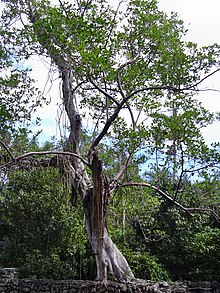Ficus aurea
| Florida strangler fig | |
|---|---|
 |
|
| Florida strangler fig in Deering Park, Florida | |
| Scientific classification | |
| Kingdom: | Plantae |
| (unranked): | Angiosperms |
| (unranked): | Eudicots |
| (unranked): | Rosids |
| Order: | Rosales |
| Family: | Moraceae |
| Genus: | Ficus |
| Species: | F. aurea |
| Binomial name | |
|
Ficus aurea Nutt. 1846, conserved name |
|
| Synonyms | |
|
Synonymy
|
|
Ficus aurea, commonly known as the Florida strangler fig (or simply strangler fig), golden fig, or higuerón, is a tree in the family Moraceae that is native to the U.S. state of Florida, the northern and western Caribbean, southern Mexico and Central America south to Panama. The specific epithet aurea was applied by English botanist Thomas Nuttall who described the species in 1846.
Ficus aurea is a strangler fig. In figs of this group, seed germination usually takes place in the canopy of a host tree with the seedling living as an epiphyte until its roots establish contact with the ground. After that, it enlarges and strangles its host, eventually becoming a free-standing tree in its own right. Individuals may reach 30 m (100 ft) in height. Like all figs, it has an obligate mutualism with fig wasps: figs are only pollinated by fig wasps, and fig wasps can only reproduce in fig flowers. The tree provides habitat, food and shelter for a host of tropical lifeforms including epiphytes in cloud forests and birds, mammals, reptiles and invertebrates. F. aurea is used in traditional medicine, for live fencing, as an ornamental and as a bonsai.
Ficus aurea is a tree which may reach heights of 30 m (98 ft). It is monoecious: each tree bears functional male and female flowers. The size and shape of the leaves is variable. Some plants have leaves that are usually less than 10 cm (4 in) long while others have leaves that are larger. The shape of the leaves and of the leaf base also varies—some plants have leaves that are oblong or elliptic with a wedge-shaped to rounded base, while others have heart-shaped or ovate leaves with cordate to rounded bases. F. aurea has paired figs which are green when unripe, turning yellow as they ripen. They differ in size (0.6–0.8 cm [0.2–0.3 in], about 1 cm [0.4 in], or 1.0–1.2 cm [0.4–0.5 in] in diameter); figs are generally sessile, but in parts of northern Mesoamerica figs are borne on short stalks known as peduncles.
...
Wikipedia
